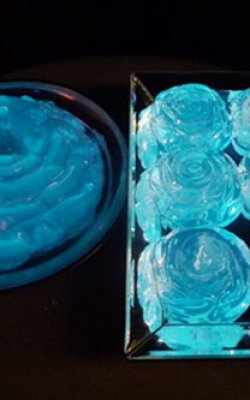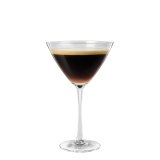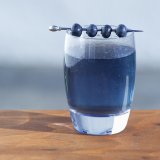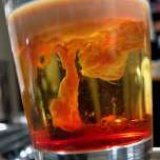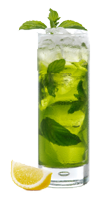Today is the the last day of Tales of the Cocktail 2010. Soon we’ll post the official Drink of the Week wrap-up on all the seminars, parties, tastes and general NOLA madness! But first I wanted to spotlight my favorite seminar of the event. Hendrick’s Gin wrangled up some fresh exotic fruit from around the world — ingredients you may find in your cocktails over the next few years. Some were pleasantly sweet, others messed with your mouth by tricking your palate or jolting your tongue like a 9-volt battery … all of them were a welcome departure from the ordinary.
Since it was a morning session, we started with a refreshing little breakfast of gin & tonic jellies with rose water by Bompas and Parr! Because of the quinine in tonic water, they glow under black light.
The journey started with mangosteen, which tastes like a lighter, less sweet lychee with a citrus quality. It has the consistency of a more solid gelatin (or jelly, as the Brits would say). This fruit is starting to show up in puree form—perfect for cocktail use—but you probably won’t see it in bars for a while.
Rambutan is similar to mangosteen and also from the Indonesia/Malaysia area. This is another one to keep an eye out for on artisinal cocktail menus over the next couple years. It’s a little sweeter than mangosteen but not as syrupy sweet as lychee. Lychee had its day in the sun on trendy cocktail menus, and I see these two fruits as less-sweet, more-complex ways to get that same exotic flavor.
Sechuan buttons from Brazil are not for the faint of heart (or mouth). This is the one presenter Jim Ryan described as a “9-volt battery.” The experiment was to chew on a sechaun button then drink a cocktail that did not have any sparkling elements, so we’d get the effect of an effervescent cocktail without the dilution of tonic water or club soda. Immediately after chewing on one of these, I felt my entire mouth tingle. The insides of my cheeks rushed with bubbles and I felt a little bite, similar to what happens if you put hydrogen peroxide in your mouth. The slightly medicinal taste quickly faded, and it was more like an herby Pop Rocks sensation.
I chased it down with an Alaska Sour (egg whites, lime, yellow Chartreuse, gin and orange bitters). The cocktail, which was quite tasty before, suddenly had an electric quality. It was a little freaky at first, leaving you wondering when your mouth will get back to normal (the sensation lasts about 5 minutes). I’d recommend it for the adventurous only. Chefs use it as a palate cleanser, and some risk-taking mixologists are grinding it up in drinks.
While we were screwing with our palates, we tried miracle fruit to see how it affected cocktails. If you haven’t heard of it before, miracle fruit makes sour taste sweet. The effect lasts about 30 minutes. We had two gimlets—one good one and one that was too sour. Pop a miracle fruit in and let it coat the tongue, and suddenly the sour one tastes sweeter. It didn’t taste like a proper gimlet but rather like a sweet chaser to a sour gimlet. At about $2 per berry, this fruit probably won’t be making the rounds except as a novelty. (Or as one farmer of it said as an aid for “adult” activities. I’ll leave that to you to interpret.)
After that, it was time for the big guns. First up: Jack fruit, which tastes and smells like banana bubble gum. It’s great! (Don’t buy it in a can … disgusting!) It’s sticky, expensive and giant. Because of this, I don’t think bartenders will mix this into your cocktails. But for home experimentation, you could really have a lot of fun pairing a little of this with other fruits and your favorite spirits … then eating the rest of it.
Our final contestant was durian, which tastes and smells like a slightly rotting cantaloupe that has been rubbed with garlic. Word on the street is it also works as a laxative. If that sounds good to you, then go for it. I’ll stay away from this one.

